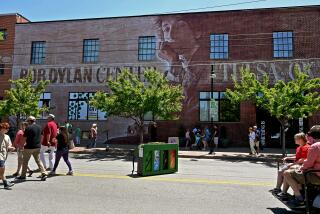Durham Nurtures Its Blues Tradition
DURHAM, N.C. — John Dee Holeman spent a lifetime working in tobacco and driving backhoes while occasionally moonlighting at house parties as a guitar-picking bluesman who played the Bull City style.
Glenn Hinson, then a student at Duke, came to Holeman’s door in 1976 determined to persuade him to play the Eno River Festival.
“I didn’t think I was up to it, but he kept encouraging me to try it,” Holeman said.
The invitation resulted in the revival of a Durham blues tradition first made popular in the 1930s by musicians like Blind Boy Fuller and the Rev. Gary Davis--two former Durham residents--and one that has influenced musicians ranging from the Grateful Dead to Garth Brooks.
Holeman, 73, has gone on to tour worldwide. “A lot of people crazy about my playing,” he said recently.
The style Holeman plays is also called the Piedmont blues, a lighter, ragtime-influenced version of the somber Mississippi Delta blues. It is distinguished by complex, two-finger guitar-picking.
The lyrics, written mostly for black audiences of the 1930s and ‘40s, touch on universal themes--hard times, booze, women, love.
At that time, Durham was the center of an enormous tobacco industry. From August to December, white and black farmers from eastern North Carolina brought their crop here for auction. A trip to town could last three days while farmers waited to see what price the leaf would bring. During that time, the visitors would sate their appetites with moonshine, prostitutes, good food and music, said Hinson, now head of the folklore department at the University of North Carolina at Chapel Hill.
Musicians mixed, with string bands and blues players playing together regardless of race.
“Music was this place in America, not the only place, but certainly the most accepted place where all those color lines didn’t have any place,” said Scott Ainslie, a blues musician and historian who lives in Durham.
Fuller, Davis and others, like harmonica player Sonny Terry and washboardist Bull City Red, made as much in a day during market as they made in an ordinary week playing at lunchtime outside the tobacco factories, Hinson said.
For these musicians, many of whom were disabled--Fuller and Davis were both blind--no other Southern town of the time offered as much promise.
There is little physical evidence of that promise today. Hinson pointed out some of the traces on a recent drive through Durham.
A state historical marker dedicated last year on Fayetteville Street, in the heart of the city’s historically black Hayti neighborhood, pays tribute to the Bull City blues. Nearby, the city has its own marker near Fuller’s gravesite.
Fuller, the most prominent figure in the Piedmont blues, recorded more than 130 songs, and his “Step It Up and Go” became a staple for most bluesmen in the country, Ainslie said.
Hinson can point out the double-shotgun house on Colfax Street where Fuller lived before his death in 1941 of a kidney ailment when he was in his early 30s.
An unfinished clapboard house used as a juke joint in the 1930s still stands on Chapel Hill Road about halfway between Durham and Chapel Hill, a reminder of the raucous parties where the musicians experimented with their sound while couples danced.
World War II and the change in musical styles led to the near-demise of the blues scene in Durham.
Today, the Hayti Heritage Center is keeping the music alive with its annual Bull Durham Blues Festival in September, setting aside stage time for aging players such as Etta Baker and Holeman.
“We’re definitely looking at the last of the old cats,” Ainslie said.
The music will live much longer in its influence on modern music, he said.
Terry and fellow musician Brownie McGhee left Durham for New York about the time of Fuller’s death. There they ran a teaching studio and mingled with Pete Seeger, Ry Cooder and other white musicians of the 1960s folk revival.
Modern country music also has some elements of Piedmont blues, with the twangy guitar solos of Garth Brooks’ recordings echoing Fuller’s rags of 60 years ago.
“This area played a pivotal role in how guitars are handled,” Ainslie said.
Holeman plucked out his first tunes as a child while waiting overnight for the family’s tobacco crop to cure. He picked up more after coming to Durham.
He has developed his own style since then, adding elements of jazz and Delta blues, but he still recognizes his Durham roots.
“I’m very proud of it, to keep it going,” he said. “I made a few bucks at it too.”
More to Read
The biggest entertainment stories
Get our big stories about Hollywood, film, television, music, arts, culture and more right in your inbox as soon as they publish.
You may occasionally receive promotional content from the Los Angeles Times.










